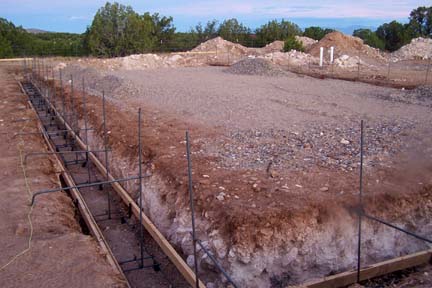The initial foundation footing for ICF walls are shown here after the excavation and leveling of the house footprint is complete. We have applied simple forms and rebar supports both horizontal and vertical. We will pour this 12 inch footing and then lay upon it 2 rows of ICFs – which are dry stacked. Then we will apply a second cement pour into the stack of ICFs which then serves as the foundation footing for the entire home. Various vapor barriers will be applied and the rest of the walls can then be raised. We are often amazed at how quickly these walls go up, given the blocks are large. In that regard (and perhaps only in that regard) they are like straw bale wall raising.
We find the ability to use the recycled Styrofoam plus cement slurry blocks as a foundation element to be a plus. As the wall breaks (gaps which could lead to air leaks) between the foundation and walls when raised are minimized.
As we are very aware that the amount of cement used in this home will be much more than other hard core natural builders believe to be a “natural” standard. But we also know that the blown cement and Styrofoam formed blocks are, as far as we have heard, one of the only ways in which Styrofoam is recycled. Would we love to see another technology replace Styrofoam? Absolutely. Should a block come upon the market which has, perhaps, recycled glass to take the place of the Styrofoam, we would be thrilled. We are always open to new technologies, as well as those which fit both the needs and budgets of our clients. Given everyone has different needs and wants with a home, we try as often as we can to adapt while providing the most sustainable option available. We are finding more and more people want to be free of the grid, and willing to go the extra mile to get there.


